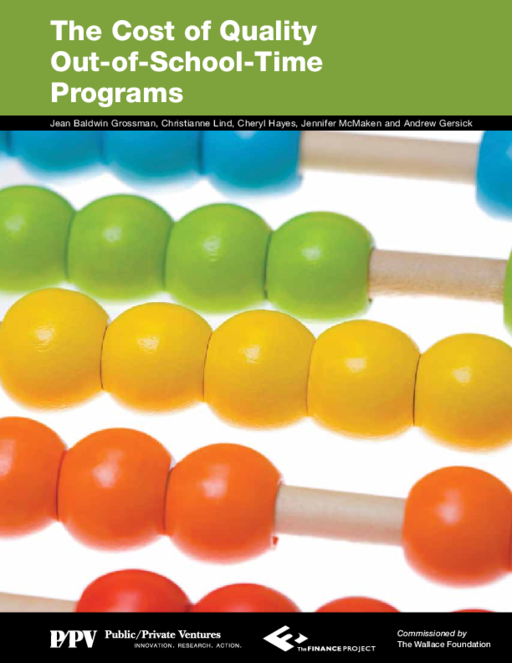Breadcrumb
- Wallace
- Reports
- The Cost Of Quality Out-Of-Schoo...
The Cost of Quality Out-of-School-Time Programs

- Author(s)
- Jean Baldwin Grossman, Christianne Lind, Cheryl Hayes, Jennifer McMaken, and Andrew Gersick
- Publisher(s)
- Public/Private Ventures and The Finance Project
Summary
How we did this
The goal of this study was to clarify the costs of high-quality out-of-school-time (OST) programs. The sampling strategy was designed to select programs that have operational practices and components that have been shown in scientific research to be associated with quality. Working in six cities—Boston, Charlotte, Chicago, Denver, New York, and Seattle—the study team solicited recommendations of highly-regarded OST programs from key informants.
Out-of-school-time (OST) programs play an important role in students’ academic and social development. OST programs keep children safe outside of school. They develop and nurture talents, and expose children to positive role models. They also can help improve academic behaviors.
There is growing demand for high-quality OST programming. To sustain, develop, and increase quality programming, it is critical to understand cost. What do strong OST programs cost to implement? And how do costs vary in different types of OST programs?
To answer these questions, The Finance Project and Public/Private Ventures conducted a full cost analysis of high-quality OST programs. Their analysis draws on data from 111 OST programs in six US cities: Boston, Charlotte, Chicago, Denver, New York, and Seattle. It focuses uniquely on high-quality programs. And it captures a variety of different types of OST programs. These include programs that serve different age groups, are located in different settings, and are run with different providers, content, and hours of operation.
Researchers found that costs across high-quality OST programs varied substantially. In 2009, for example, the cost of elementary school programming ranged from $3 to $9 per hour per slot, with an average cost of $7 per hour. Staff costs were the primary cost driver. Geography also mattered, owing to cost-of-living differences. City and district-level policies could also affect cost.
OST programs typically relied on three to five sources of funding, balancing public and private sources. In-kind contributions accounted for one-fifth of OST programs’ resource needs. The contributions included donated goods and services in the form of rent-free facilities, volunteers, and in-kind equipment and supplies.
Policymakers and funders want to know the “return” on their OST investments. This study reveals half of the answer by providing the best information available as of 2009 on the cost of OST programs. The authors caution, however, that without information on impacts, cost data generally lead to strategies to minimize cost. While the report findings can help policymakers, program directors, and funders plan and budget, it is important to consider the needs of children and families in the areas being served.
An online cost calculator, based on the study and updated in 2021, can help users determine the costs of various OST options.
Key Takeaways
- Costs across OST programs varied substantially. Hours of operation, activities offered, and staffing ratio affected costs. Available funding, local conditions, and cost structures in different cities also contributed to cost differences.
- Based on the data published in 2009, OST programs serving elementary school students cost an average of $24 per day per slot during the school year, and $32 per day during the summer. For teen programs, the average daily cost during the school year was $33 per day. During the summer, it was $44 per day.
- Because OST programs typically enroll more children than the number present each day, the average cost per child enrolled was substantially lower than the average cost per slot.
- OST programs typically relied on three to five sources of funding to support programming. This includes both private and public funding sources.

While being cost-efficient is desirable, different types of programs that serve different types of youth use different levels of resources.


